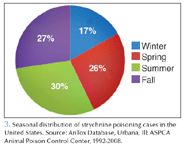Toxicology Brief: Epidemiology and management of strychnine poisoning
The ASPCA APCC reports 146 strychnine poisoning cases throughout the United States.
Strychnine is a bitter indole alkaloid obtained mainly from the seeds of Strychnos nux-vomica and Strychnos ignatii.1 These vine-like trees are indigenous to some southeast Asian countries and northern Australia. All parts of S. nux-vomica and S. ignatii may contain strychnine and brucine (dimethoxystrychnine), a related but less potent alkaloid.1,2
Dried seeds from S. nux-vomica have been used to make extracts, powders, and tinctures of strychnine alkaloid. These preparations have been used as bitters, cathartics, tonics, stimulants, and ruminatorics in the past, but now their use is considered ineffective and dangerous.1 The strychnine content of the dried seeds usually varies from 1% to 2%.2
In this article, we discuss strychnine poisoning cases in animals, its diagnosis, and its treatment as reported in the literature. This article also discusses the ASPCA Animal Poison Control Center's (APCC) strychnine incident data from January 1992 to December 2008.
STRYCHNINE AS PESTICIDE
Since 1978, Environmental Protection Agency (EPA) guidelines have classified strychnine as a restricted-use pesticide except for baits containing strychnine alkaloid at a concentration of 0.5% or less. These baits are generally labeled for below-ground use and are intended for the control of burrowing rodents.3 Numerous states have enacted stricter laws than the EPA guidelines, either forbidding the sale of strychnine to the general public or requiring those who purchase strychnine to register.2
Strychnine-containing baits are mostly used to poison birds, gophers, mice, moles, rats, rabbits, porcupines, and wild carnivores such as coyotes, foxes, and wolves. Bait pellets or strychnine-laced grains are usually dyed green or red. The manufacturer of the last strychnine alkaloid product intended to control house mice canceled its registration in 1989, thereby eliminating all indoor uses of strychnine pesticides.3
PREVALENCE
Malicious or accidental strychnine poisoning cases have been described in several animal species.4-11 In a nationwide survey conducted through the veterinarian members of the American Animal Hospital Association, 415 (12%) of 3,452 poisoning cases were attributed to strychnine.4 Most of these cases were reported based on clinical assessment and were not confirmed by chemical analysis.4 In Alberta, Canada, from April 1990 to September 1990, 57 stomach content samples were submitted for strychnine analysis, and 31 were positive for strychnine.5 Kansas State University Veterinary Teaching Hospital reported 10 cases (7%) of strychnine poisoning in dogs out of 139 large- and small-animal poisonings from 1975 to 1980.6
A review of the ASPCA APCC database shows that 161 strychnine cases were reported from January 1992 to December 2008 (Figure 1). Out of 161 cases, dogs accounted for 82% of the cases (n=132), horses 7% (n=12), cats 4% (n=7), pigs 3% (n=4), and birds 1% (n=2).

Figure 1. Yearly distribution of strychnine poisoning cases in the United States. Source: AnTox Database, Urbana, Ill: ASPCA Animal Poison Control Center, 1992-2008.
The data are consistent with earlier published reports in which strychnine poisoning had been described mainly in small animals—especially in dogs and occasionally in cats—and rarely in livestock.1,7 Other reports have also shown that dogs are more frequently involved in strychnine poisoning cases than are other species.8 For example, in Oklahoma, 162 cases of suspected strychnine poisoning in dogs during a three-year period were described.8 Of the 162 cases investigated, 38 were confirmed by analytical methods, 19 were considered malicious, six were accidental, and 13 cases were not classified into any category.8 In Saskatoon, Canada, 261 cases of strychnine poisoning were confirmed from 1968 to 1982.9 These cases showed that strychnine poisoning was more common in young and large-breed dogs such as German shepherds, male dogs were more commonly affected, and dogs from rural or urban areas were equally affected.
Regional incidence
Only a few published reports in the veterinary literature discuss the epidemiologic aspects of strychnine poisoning cases in animals. Most of these reports describe a regional incidence of strychnine poisoning in dogs. In one report, among the rodenticides, strychnine was listed as the most common agent involved (415 incidents), and the highest number of cases (37%; n=154) was reported from the Midwest region.4
The ASPCA APCC collected information on geographic location in 146 poisoning cases (Figure 2). The states with the highest number of cases were California (34%), Ohio (9%), and Arizona (8%). Regional distribution of the cases showed that more cases were reported from the West (55%; n=80) and Midwest (23%; n=33) than from any other region. The greater incidence in the West may be because of the area's proximity to Mexico where strychnine may be more readily available.

Figure 2. Regional distribution of strychnine poisoning cases in the United States. Source: AnTox Database, Urbana, Ill: ASPCA Animal Poison Control Center, 1992-2008.
Seasonality
According to one report, strychnine poisoning has not been regarded as seasonal since cases have been reported throughout the year.9 The ASPCA APCC data also showed strychnine poisonings occurring throughout the year, although more cases were reported during summer months (Figure 3).

Figure 3. Seasonal distribution of strychnine poisoning cases in the United States. Source: AnTox Database, Urbana, Ill: ASPCA Animal Poison Control Center, 1992-2008.
CLINICAL SIGNS
According to ASPCA APCC data, 93 dogs had clinical signs of strychnine poisoning, and the most commonly reported sign was seizures (56%, n=52) (ASPCA APCC Database: Unpublished data, 1992-2008). Other signs included tremors (26%, n=24), rigidity or stiffness (20%, n=19), panting (14%, n=13), hyperthermia (12%, n=11), vomiting (11%, n=10), ataxia (10%, n= 9), and hyperesthesia (9%, n=8). Of the 93 dogs that exhibited clinical signs, nine (10%) died or were euthanized. Most dogs in the current report had a combination of central nervous system signs (seizures, tremors, ataxia, and hyperesthesia).
Strychnine is a competitive and reversible inhibitor of the inhibitory neurotransmitter glycine at postsynaptic neuronal sites in the spinal cord and medulla.1,2,10 The resulting unchecked reflex stimulation of motor neurons affects all the striated muscles, resulting in generalized rigidity and tonic-clonic seizures.
The onset of strychnine poisoning is rapid. Signs normally appear within 10 minutes to two hours after oral administration.7 Early signs may consist of apprehension, nervousness, tenseness, and muscle stiffness.1,2 Severe tetanic seizures may appear spontaneously or may be initiated by external stimuli such as touch, sound, or a sudden bright light. Usually, extreme and often overpowering extensor rigidity causes the animal to assume a sawhorse stance. The tetanic convulsion may last from a few seconds to about a minute. Intermittent periods of relaxation are observed during convulsions and become less frequent as the clinical course progresses. During convulsions, the animal exhibits opisthotonos, the forelimbs are extended, the pupils are dilated, the eyeballs protrude, and the mucous membrane color is cyanotic. The frequency of the tonic-clonic seizures increases, and death eventually occurs from respiratory failure or exhaustion during seizures. The entire syndrome, if untreated, may last less than one or two hours.
Postmortem examination reveals no characteristic lesions. Patients that have prolonged convulsions before death may exhibit agonal hemorrhages of the heart and lungs and cyanotic congestion due to anoxia. Death usually results from respiratory arrest and exhaustion from prolonged seizures.1,2
TOXICOKINETICS
Strychnine is ionized in an acidic pH; thus, it is mainly absorbed in the small intestine.1 It is metabolized in the liver by microsomal enzymes. In vitro studies indicate that cytochrome P-450 monooxygenase is the predominant metabolic enzyme involved and that strychnine-N-oxide is the major metabolite.2 Strychnine does not appear to concentrate in nervous tissues. Its highest concentration is found in the blood, liver, or kidneys.1 Strychnine and its metabolites are mainly excreted in urine.1,2 About 10% to 20% of the parent compound appears unchanged in the urine within 24 hours.2 Depending on the quantity ingested and the treatment measures taken, most of the toxic dose is eliminated within 24 to 48 hours after exposure. The approximate lethal dose in dogs and cats is 0.75 mg/kg and 2 mg/kg, respectively.1
DIAGNOSIS
Strychnine poisoning can be tentatively diagnosed based on a history of exposure, typical clinical signs (rapid onset of muscular rigidity, tonic seizures, sawhorse stance, rapid rigor mortis), and a lack of postmortem lesions. Poisoned animals may have undigested red or green strychnine-laced seeds or grain such as peanuts, wheat, milo, or barley in their stomach. Analytical detection of strychnine alkaloid in the vomitus, stomach content, liver, kidneys, or urine should be considered diagnostic.1,2,8,11
In living animals, the best chance of finding strychnine alkaloid is in stomach content (in vomitus or through stomach washings)9 or in urine if samples are collected within the first several hours of exposure. Urine samples may not contain detectable amounts of strychnine if they are collected one or two days after exposure. Samples (stomach content, liver, or kidney) should be sealed in a plastic bag, frozen, and submitted to a veterinary diagnostic laboratory for strychnine analysis.
Strychnine poisoning can be confused with—and should be ruled out from—several other types of poisonings such as metaldehyde, chlorinated hydrocarbon pesticides, zinc phosphide, fluoroacetate, nicotine, 4-aminopyridine, organophosphate pesticides, carbamate pesticides, permethrin (in cats), and tremorgenic mycotoxins such as penitrem A and roquefortine by obtaining a thorough history and requesting additional toxicological analyses.1,2,5
TREATMENT
Treatment of strychnine poisoning is considered an emergency and should be instituted quickly. The objectives of treatment are 1) decontamination in asymptomatic animals, 2) controlling seizures and preventing asphyxiation in symptomatic animals, and 3) supportive care.
Decontamination
Since strychnine is a rapidly acting convulsant, most animals presented to a veterinarian are already exhibiting clinical signs. Do not attempt decontamination in animals that are already showing neurologic effects. Control seizures and stabilize the animal first (discussed below) before decontamination.
Decontamination consists of removing gastric contents either by inducing emesis or by gastric or enterogastric lavage and binding the remaining bait in the gastrointestinal tract with activated charcoal.
Emesis. If the exposure is recent and no clinical signs are present, induce vomiting with 3% hydrogen peroxide (2.2 ml/kg orally for a maximum of 45 ml in dogs; repeat once after 10 to 15 minutes if no vomiting occurs), apomorphine in dogs (0.03 mg/kg intravenously; 0.04 mg/kg intramuscularly; or dissolve a crushed pill in physiologic saline, instill in the conjunctival sac, and rinse with water after emesis has occurred),12 or xylazine (cats = 0.44 mg/kg intramuscularly; dogs = 1.1 mg/kg subcutaneously or intramuscularly).13 Yohimbine (0.1 mg/kg intravenously in dogs) can be given to reverse the effects of xylazine.13
Induce emesis with great caution since it could trigger seizures in an asymptomatic animal due to stress and due to the fast-acting nature of strychnine. Do not induce emesis in hyperesthetic, anesthetized, or convulsing animals.
Gastric lavage. Animals receiving gastric lavage should be anesthetized and intubated with a cuffed endotracheal tube to reduce the risk of aspiration. Tepid water at body temperature can be instilled through a gastric tube at 10 ml/kg.14 Use gravity to instill and to drain the liquid, and repeat until the lavage fluid becomes clear. Use large bore tubes and multiple flushes for better results.
Enterogastric lavage. Enterogastric lavage, also called a through and through, begins with gastric lavage followed by an enema under low pressure and continues until fluids exit through the gastric tube. Give a preanesthetic dose of atropine (0.02 to 0.04 mg/kg subcutaneously, intramuscularly, or intravenously)12 before the procedure to relax the patient's intestinal muscles and allow fluids to flow easily. After enterogastric lavage administer activated charcoal (2 to 3 g/kg mixed with water to make a slurry) with a cathartic such as sorbitol (70% solution at 1 to 2 ml/kg).14
Seizure control
If convulsions are present or imminent, intravenous pentobarbital sodium is the drug of choice in small animals. It should be given to effect and repeated as often as necessary. Muscle relaxants such as methocarbamol (100 to 200 mg/kg intravenously; repeat as needed up to a maximum dose of 330 mg/kg/day) or guaifenesin (5% solution at 110 mg/kg intravenously)14,15 can be tried. Diazepam and xylazine have been used to control strychnine seizures in dogs with variable success.14 Propofol (3 to 6 mg/kg intravenously or 0.1 mg/kg/min as an infusion) can also be tried.12 Isoflurane inhalation anesthesia can be used if seizures are not controlled with the preceding treatment measures.
Supportive care
Intubate severely affected animals, and provide artificial respiration. Urine acidification with ammonium chloride (100 mg/kg orally b.i.d.) may be useful for ion-trapping and urinary excretion of the alkaloid. Administer intravenous fluids to maintain normal kidney function and promote diuresis. Monitor and correct the animal's acid-base balance as needed.
Maintain the animal's body temperature within the normal range. In strychnine-poisoned dogs, hyperthermia can occur as result of severe muscle fasciculation or seizures. Aggressive cooling, by means of ice baths or cold water enemas, may result in hypothermia and should be avoided. All cooling measures should be stopped when rectal temperature reaches 102 F (38.9 C) to prevent rebound hypothermia.16
Keep affected animals in a dark quiet room until they have recovered. Most animals may require one to three days of treatment.
CONCLUSION
Sporadic strychnine poisoning still occurs in animals in the United States, even though human poison control data indicate a decline of 63% in strychnine exposures in people between 1995 and 2004.17 Most strychnine cases in animals are reported in the West, possibly because of the region's proximity to Mexico where strychnine may be more readily available.
EPA guidelines restrict the use of strychnine to below-ground use. Stricter state and federal guidelines for the use and availability of strychnine may help reduce these accidental and potentially deadly poisoning cases.
"Toxicology Brief" was contributed by Safdar A. Khan, DVM, MS, PhD, DABVT, and Mary Kay McLean, BS, ASPCA Animal Poison Control Center, 1717 S. Philo Road, Suite 36, Urbana, IL 61802. The department editor is Petra Volmer, DVM, MS, DABVT, DABT.
REFERENCES
1. Osweiler GD, Carson TL, Buck WB, et al. Strychnine. In: Clinical and diagnostic veterinary toxicology. 3rd ed. Dubuque, Iowa: Kedall/Hunt Publishing Co, 1985;345-348.
2. MICROMEDEX editorial staff. Strychnine. Anderson M, et al., eds. MICROMEDEX Healthcare Series Integrated Index, Vol. 102. Englewood, Colo: MICROMEDEX, expires 12/04.
3. United States Environmental Protection Agency. Reregistration Eligibility Decision (RED) Facts: Strychnine. Prevention, Pesticides, and Toxic Substances. July 1996.
4. Osweiler GD. Incidence and diagnostic consideration of major small animal toxicoses. J Am Vet Med Assoc 1969;155:2011-2015.
5. Lowes NR, Smith RA, Beck BE. Roquefortine in the stomach contents of dogs suspected of strychnine poisoning in Alberta. Can Vet J 1992;33:535-538.
6. Barton J, Oehme FW. The incidence and characteristics of animal poisonings seen at Kansas State University from 1975 to 1980. Vet Hum Toxicol 1981;23:101-102.
7. Morgan S, Martin T, Edwards WC, et al. Investigating a case of strychnine poisoning. Vet Med 1987;82:1044-1047.
8. Edwards WC, Kerr LA, Whaley MW. Strychnine poisoning in dogs: sources and availability. Vet Med Small Anim Clin 1981;76:823-824.
9. Blakley BR. Epidemiologic and diagnostic considerations of strychnine poisoning in the dog. J Am Vet Med Assoc 1984;184:46-47.
10. Martens PR, Vandevelde K. A near lethal case of combined strychnine and aconitine poisoning. J Toxicol Clin Toxicol 1993;31:133-138.
11. Warnock N, Schwarzbach SE. Incidental kill of dunlin and killdeer by strychnine. J Wildl Dis 1995;31:566-569.
12. Plumb DC. Plumb's veterinary drug handbook. 6th ed. Stockholm, Wis: PharmaVet Inc, 2008.
13. Hall K. Toxicosis treatments. In: Bonagura JD, Twedt DC, eds. Kirk's current veterinary therapy XIV: small animal practice. St. Louis, Mo: WB Saunders, 2009;112-116.
14. Kahn CM, Line S. The Merck veterinary manual. 9th ed. Whitehouse Station, N.J.: Merck & Co Inc, 2005.
15. Bailey EM, Szabuniewicz M. Use of glyceryl guaiacolate ether in treating strychnine poisoning in the dog. Vet Med Small Anim Clin 1975;70:170-174.
16. Podell M. Seizures and sleep disorders. In: Morgan RV, ed. Handbook of small animal practice. 3rd ed. Philadelphia, Pa: WB Saunders Company, 1997;220-229.
17. Blondell JM. Decline in pesticide poisonings in the United States from 1995 to 2004. Clin Toxicol 2007;45:589-592.